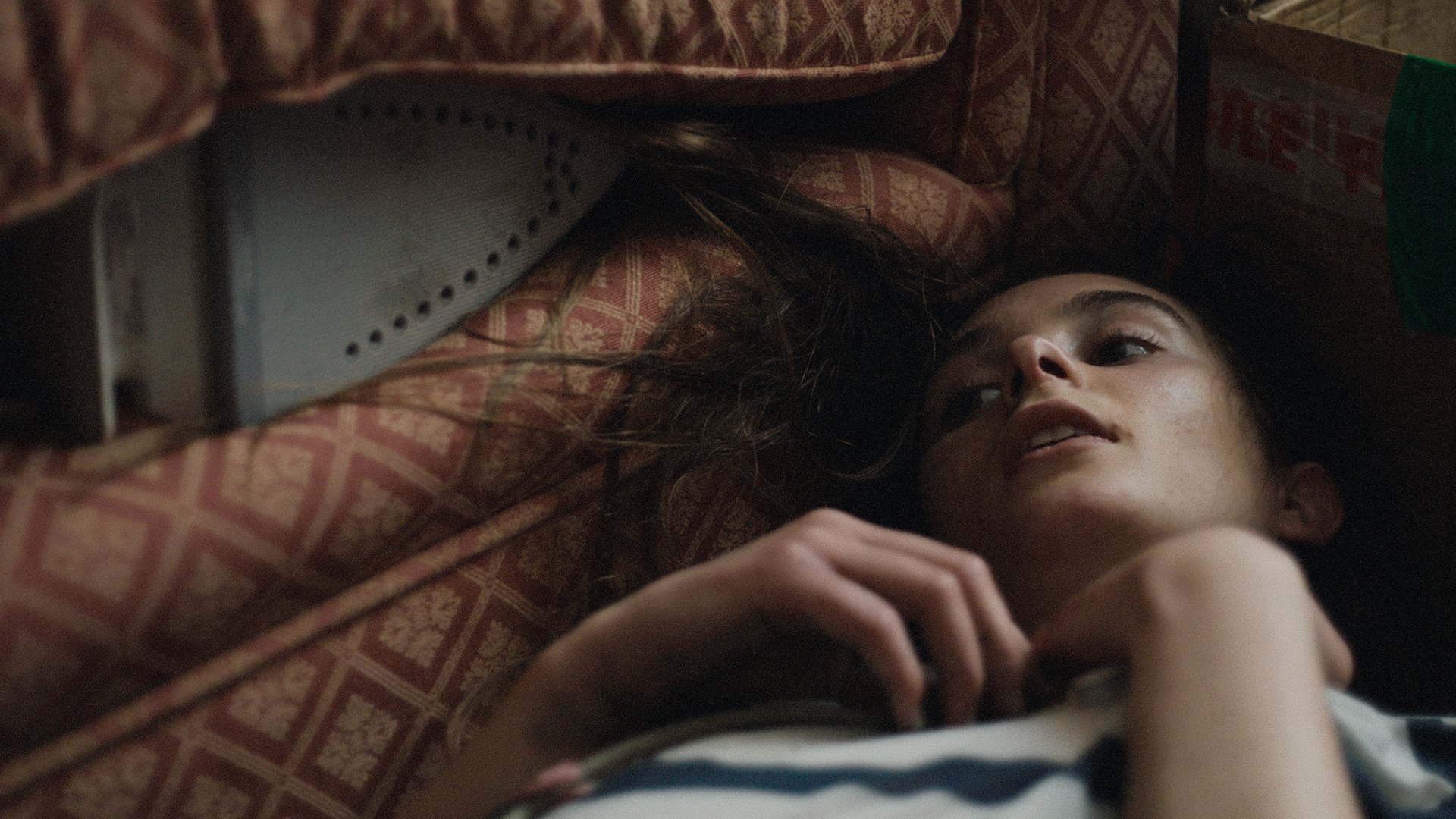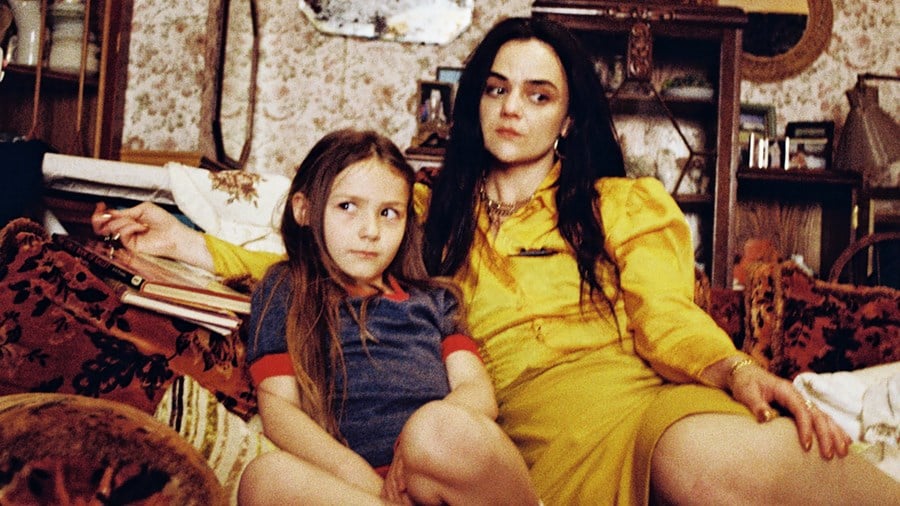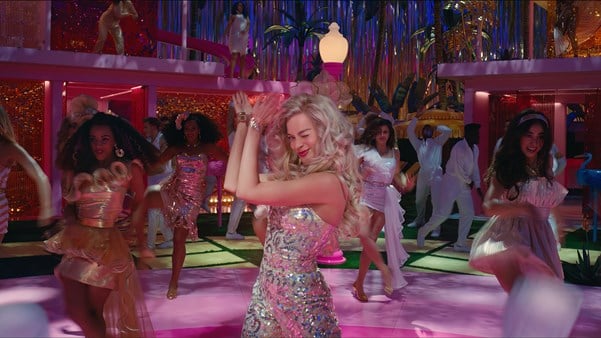A far cry from the immaculate pretty-pink worlds of Barbie and Priscilla, Hoard revels in the more disgusting aspects of young womanhood that so much cinema pointedly ignores, writes Miriam Balanescu.

When we see girlhood on screen, we expect it to be sugar-coated, even sickly-sweet. Film has solidified this nebulous, often difficult-to-define experience into a series of lingering images: the luminous white dresses of schoolgirls in Picnic at Hanging Rock (1965) or the pristinely manicured mien of the underage Priscilla Presley. (Sofia Coppola’s recent biopic is just her latest delicately wrought portrait of a young woman.)
This pastel-washed, pink-saturated conception of girlhood was compounded by the frenzy around Greta Gerwig’s Barbie last year. While it offered an opportunity for cinemagoers to don their Barbie-themed finery, the film did not go particularly far in dispelling deep-seated notions around gender. In its wake, however, a new ream of films is delving into the darker recesses of girlhood, refusing to cut corners around its more perturbing – sometimes gloriously disgusting – aspects.

Priscilla (2023)
Luna Carmoon’s feature debut Hoard gets right to the crux of the grossness girls are capable of. The first section of the film is told from the perspective of seven-year-old Maria (Lily-Beau Leach), when the hoarding of her mother (Hayley Squires) complicates the child’s life and leaves her adrift in a sea of rubbish bags. Cut to 10 years later and Maria (Saura Lightfoot-Leon) – now living with her foster mum Michelle (Samantha Spiro) – receives her mother’s ashes and is sent spiralling into grief.
The film is rife with gunk, gore, spit, chilblains and piss, and it has a fascination with bodily fluids to rival the male protagonists of American Pie (1999) or even the notorious grotesquery of Gummo (1997). From the filmography of the Farrelly brothers to the work of Todd Phillips, gross-out comedy has long made the more stomach-churning side of human nature seem to be only the domain of men. But in one fell slash of ‘horse’-like urine, Maria erases any preconception about girls’ and non-binary people’s capacity for vulgarity.

Hoard acts as an off-kilter companion piece to Priscilla (2023), where details like the unblemished white fibres of a carpet, the gently rustling packaging of designer products and the careful placing of a fake eyelash collude to create an entrancing, almost hypnotic effect. In Hoard, we are given the reverse. With her mother’s magpie-like stockpiling, grime and filth become the norm of Maria’s childhood. When Maria finds out her mother has died, she embarks on a summer fling with, ironically, 27-year-old binman Michael (Joseph Quinn)
Saddled with the uneasy legacy of girls being treated as sexual objects by older men – along with Priscilla, The Diary of a Teenage Girl (2015) and Stanley Kubrick’s Lolita (1962) are prime examples – Carmoon’s film equates its literal disorderliness with the messiness of a young woman’s burgeoning sexuality, grief and sense of identity. ‘I wanted to capture that time in your childhood before you’re given shame,’ Carmoon told A Rabbit’s Foot. ‘There’s that pre-pubescence of not understanding what’s sexual but understanding in your animal what is.’

Hoard (2023)
When Maria and Michael eventually have sex, in an unnerving Freudian twist she remains fixated on the garbage she has stuffed beneath the sofa. While their dalliance is steamy and strange, it is in no way idealised – the film allows the ambivalence around their relationship to stew.
Taking Hoard’s unruly fantasies to the extreme, Yorgos Lanthimos’ Frankenstinian Poor Things (2023) stamps out all traces of stereotypical girliness, populating the universe of Bella Baxter (Emma Stone) with wacky surgically modified animals and – far from Margot Robbie’s platinum blondeness in Barbie – bestowing her with Gothically black locks. Much like Maria, Bella is unfettered in her pursuit of her desires, and, as she romps her way round Europe, the only ramification of her having a baby girl’s brain in her adult head is her open-mindedness in response to the weirdness – and sometimes repulsiveness – of the world.

Poor Things (2023)
Directed by Zelda Williams and written by Jennifer’s Body’s Diablo Cody, Lisa Frankenstein (2024) also occupies similarly Gothic turf. In it, its titular oddball, tomb-rubbing character Lisa (Kathryn Newton) finds her perfect man in an utterly decayed, reanimated but unspeaking corpse, and they become locked in love and bloodlust. Unlike with so many filmic teen-girl outsiders past, Lisa’s unconventional yearnings (rotting, ‘stinky tears’ and decapitation included) are not seen in the context of horror, but sweet romance.
Hoard finds its own ways to satirise the soft-hued backdrop to so many portrayals of girlhood. Chasing breadcrumbs of memories left by her biological mother, Maria remembers a gift she gave her of a jar filled with chalk gathered from the streets over the course of a year, their ‘endless catalogue of love’. Rather than daubing Maria’s face with make-up, her mother brushes her cheeks with chalk. As present-day Maria rubs chalk from a snooker table into her skin, the screen is imbued with a radiant, rose-tinted light. The next day, a nasty rash spreads across her face.

Lisa Frankenstein (2024)
There are also subtler subversions of the cinematic canon of girlhood in Hoard (in as much as any reference to excrement can be subtle). A scene paying homage to rom-com makeover montages is punctuated by Maria quizzing her best friend Laraib (Deba Hekmat) about what she would do to prove her devotion. ‘Would you eat my shit?’ Maria ventures, a comment the film does not pause to interrogate, but is instead reflective of the bizarreness of many real conversations between teen girls, and treated as fairly banal.
Another recent release, Amanda Nell Eu’s neon-shaded Tiger Stripes (2023), operates in a similar vein to Julia Ducournau’s Raw (2016) in transposing female puberty into body horror. But where Raw – and many other horrors – see a throughline between blood and sex, Nell Eu is emphatic about the repellent side of girlhood. Like in Hoard, foul odours permeate these girl’s lives. Rather than an object of desire, the teen protagonist Zaffan (Zafreen Zairizal) becomes an object of disgust when she gets her first period and is forced to skip prayers at her conservative Muslim school. Nell Eu riffs on Malaysian folklore while mocking the traditionalist values of Zaffan’s peers. The schoolgirl angers demons by not washing out her sanitary products properly and begins a transformation into a bloodthirsty creature. She also begins to stink, and red blots break out across her body. One classmate tells her, ‘Every time I see you, I want to vomit.’

Tiger Stripes (2023)
Of these recent representations of girlhood, Hoard stays the closest to realism, albeit with a few magic-realist touches. In perhaps its grossest scene, Maria and Michael spurt a seemingly endless stream of spit onto sweets in Maria’s hand, before each taking a generous lick. This encapsulates Carmoon’s wry rebellion against the glossy, syrupy versions of girlhood in film that have gone before, paving the way for more unbridled, unapologetically idiosyncratic, and ultimately more realistic representations of young women and non-binary people to follow.
WATCH HOARD IN CINEMAS




